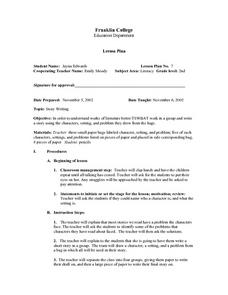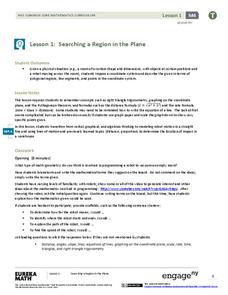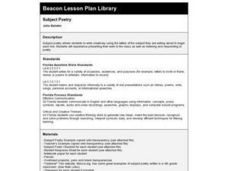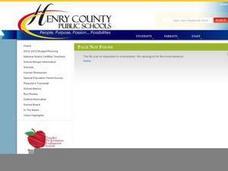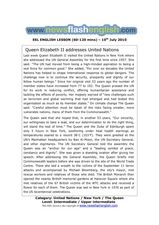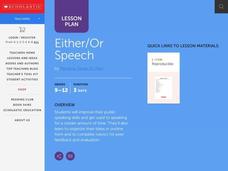Curated OER
Creating A Story
Second graders practice the necessary steps that should be taken in order to create a story from scratch. They brainstorm as a class in order to come up with different ideas. Students write a story that includes a plot, characters, and...
Curated OER
HIV/AIDS Education
Students in an ESL classroom brainstorm on activities already being done around the country to raise the awareness of HIV and AIDS. In groups, they develop and create a leaflet or brochure to target young children on how to prevent...
Curated OER
Health Education: An Integrated Approach; Causes of Violence
Fourth graders brainstorm about situations that they think may lead to violence in order to learn how to predict when violence might occur. In this lesson on violence, 4th graders first participate in an activity to demonstrate how...
Curated OER
Modeling Day and Night
Students complete a science experiment to study the role of night and day on sleep patterns. In this sleep patterns lesson, students brainstorm about night and day and the causes for the rotations on Earth. Students work in groups to...
Curated OER
Telling My Story: Conducting and Writing an Oral History
Students analyze the use of oral history as a way of gathering history. In this oral history lesson, students define oral history and then discuss researching immigration. Students research immigration. Students create questions for to...
EngageNY
Searching a Region in the Plane
Programming a robot is a mathematical task! The activity asks learners to examine the process of programming a robot to vacuum a room. They use a coordinate plane to model the room, write equations to represent movement, determine the...
EngageNY
Why Are Vectors Useful? 1
How do vectors help make problem solving more efficient? Math scholars use vectors to represent different phenomenon and calculate resultant vectors to answer questions. Problems vary from modeling airplane motion to the path of a robot.
EngageNY
Applications of Systems of Equations and Inequalities
Is the application of systems of equations giving your class headaches? Use this resource to build on your pupils' logic to lead them to building equations and using algebraic methods. The instructional activity begins with an...
EngageNY
Comparing Quadratic, Square Root, and Cube Root Functions Represented in Different Ways
Need a real scenario to compare functions? This lesson has it all! Through application, individuals model using different types of functions. They analyze each in terms of the context using the key features of the graphs.
EngageNY
Informal Proofs of Properties of Dilations
Challenge the class to prove that the dilation properties always hold. The instructional activity develops an informal proof of the properties of dilations through a discussion. Two of the proofs are verified with each class member...
Curated OER
Subject Poetry
Students examine subject poems and brainstorm a list of possible topics for their own poems. They create a poem using the letters of the subject they are writing about to begin each line. Then they present their work to the class.
Curated OER
Idea Generator
Second graders listen to a story about gift giving and letter writing and generate a class list of presents they have received.
Curated OER
Exposition
Students brainstorm, plan, and organize expository essay topics, and practice word processing and writing skills at the computer.
Curated OER
Street Language and Learning
Learners examine the type of language they use on the street in the city. In groups, they brainstorm ideas about a topic they decide on from a cluster of words. Using those ideas, they organize them into a written paper using proper...
Curated OER
Pollution Solution
Students explore the topic of oil pollution and how it affects the global ocean. They discuss oil spills in recent history and use problem solving skills to decide what strategies could be used to actually clean up an oil spill. Students...
Curated OER
School-Home Links: Writing Descriptions
For this descriptive writing worksheet, students review the process of descriptive writing. Students choose a topic from the given list and then complete the brainstorming checklist. Parents or guardians must sign the worksheet.
Curated OER
Social Networking in Today’s World
Students explore social networking in today's world. In this ESL lesson, students discuss the various methods of social networking then complete a vocabulary assignment and brainstorming activity to reinforce the topic.
Curated OER
Queen Elizabeth II Addresses United Nations
Students examine an article that discusses Queen Elizabeth's address to the United Nations General Assembly. In this lesson, students complete several assignments that are centered around the topic of the article, including vocabulary,...
Teaching Tolerance
Musical Movement Showcase
Young performing artists create a song or choreograph a dance to illustrate a theme in a text they are reading. Step-by-step directions are included.
Teaching Tolerance
Community Newsletter
What does it take to develop and publish a newsletter? Young academics create a newsletter with original artwork for their school or community. They explore social justice themes and spread messages of tolerance and inclusion. Scholars...
Teaching Tolerance
Community Bulletin Board
A project-based lesson has pupils create a bulletin board to share artwork, nonfiction articles, and messages based on social justice themes. The finished board is displayed in the community to create a place for discussion.
Curated OER
Dealing With Bullies
Students identify bullying behaviors and identify strategies for dealing with bullies. They participate in role-plays and discuss the experience later as a group. After role-playing scenarios provided by the teacher, students create...
Curated OER
Babes in Electronic Toyland
Students read a New York Times article in order to explore the use of handheld electronic devices in schools. They investigate, through surveys and essay-writing, the pros and cons of this technology.
Curated OER
Either/Or Speech
Have your high schoolers practice their public speaking skills by writing an either/or speech. Individually, they complete an outline on what they want to discuss and give their speech to the class. To end the lesson, they complete a...


